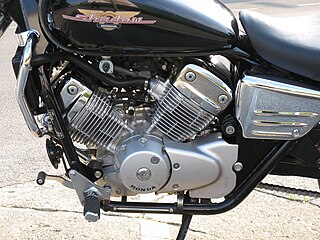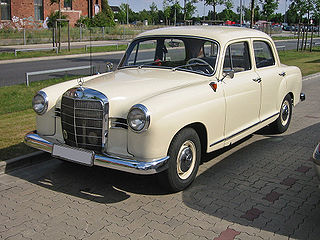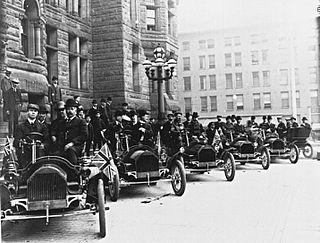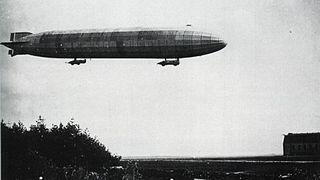Related Research Articles

A military armoredcar is a lightweight wheeled armored fighting vehicle, historically employed for reconnaissance, internal security, armed escort, and other subordinate battlefield tasks. With the gradual decline of mounted cavalry, armored cars were developed for carrying out duties used to be assigned to light cavalry. Following the invention of the tank, the armored car remained popular due to its faster speed, comparatively simplified maintenance and low production cost. It also found favor with several colonial armies as a cheaper weapon for use in underdeveloped regions. During World War II, most armored cars were engineered for reconnaissance and passive observation, while others were devoted to communications tasks. Some equipped with heavier armament could even substitute for tracked combat vehicles in favorable conditions—such as pursuit or flanking maneuvers during the North African Campaign.

A V-twin engine, also called a V2 engine, is a two-cylinder piston engine where the cylinders share a common crankshaft and are arranged in a V configuration.

The straight or inline engine is an internal combustion engine with all cylinders aligned in one row and having no offset. Usually found in four, six and eight cylinder configurations, they have been used in automobiles, locomotives and aircraft, although the term in-line has a broader meaning when applied to aircraft engines, see Inline engine (aviation).

The Saxon Motor Car Company was located in Detroit, Michigan, from 1914 to 1922. In 1917, 28,000 cars were made, making it the seventh largest car maker in the United States.

L'Aster, Aster, Ateliers de Construction Mecanique l'Aster, was a French manufacturer of automobiles and the leading supplier of engines to other manufacturers from the late 1890s until circa 1910/12. Although primarily known as an engine mass manufacturer the company also produced chassis for coach-works and a complete range of components.

A U engine is a piston engine made up of two separate straight engines placed side-by-side and coupled to a shared output shaft. When viewed from the front, the engine block resembles the letter "U".

A trunnion is a cylindrical protrusion used as a mounting or pivoting point. First associated with cannons, they are an important military development.

The Stutz Motor Car Company, was an American producer of high-end sports and luxury cars based in Indianapolis, Indiana. Production began in 1911 and ended in 1935.

Wolseley Motors Limited was a British motor vehicle manufacturer founded in early 1901 by the Vickers armaments combine in conjunction with Herbert Austin. It initially made a full range, topped by large luxury cars, and dominated the market in the Edwardian era. The Vickers brothers died and, without their guidance, Wolseley expanded rapidly after the war, manufacturing 12,000 cars in 1921, and remained the biggest motor manufacturer in Britain.

The Mercedes-Benz W 120 and Mercedes-Benz W 121 are technically similar inline-four cylinder sedans made by Daimler-Benz. The W 120 was first introduced by Mercedes-Benz in 1953. Powered initially by the company's existing 1.8 liter M 136 engine, it was sold as the Mercedes-Benz 180 through 1962. From 1954, Mercedes-Benz also offered the W 120 with a diesel engine as the Mercedes-Benz 180 D. The Mercedes-Benz W 121 was introduced as the Mercedes-Benz 190 in 1956, powered by a 1.9 liter M 121 engine. From 1958, the W 121 was also offered with an OM 621 engine, sold as the Mercedes-Benz 190 D through 1961.

Elmore Manufacturing Company was a manufacturer of veteran and brass era automobiles and bicycles (1893–97), headquartered at 504 Amanda Street, Clyde, Ohio, from 1893 until 1912. The company took its name from a small parcel of land in Clyde with the name Elmore associated with it where a stave mill was established originally, then evolved into bicycle production. The village of Elmore, Ohio is located 20 mi (32.2 km) to the east. Founded by Harmon Von Vechten Becker and his two sons, James and Burton, the Elmore used a two-stroke engine design, in straight twin or single-cylinder versions. They later produced a straight-3 followed by a straight-4 beginning in 1906 until production ended in 1912. The company advertising slogan was "The Car That Has No Valves", referring to the two-stroke engine.

Motor Rail was a British locomotive-building company, originally based in Lewes, Sussex, they moved in 1916 to Bedford. In 1987 loco manufacture ceased, and the business line sold to Alan Keef Ltd of Ross-on-Wye, who continue to provide spares and have built several locomotives to Motor Rail designs.
Crane-Simplex, formerly known as the Simplex Automobile Company, was a car manufacturer, operating in New York City and New Brunswick, New Jersey, at the beginning of the 20th century.

The Austin 10 hp is a high-quality small car produced between 1910 and 1915 by the British car manufacturer Austin Motor Company Limited at their Longbridge, Worcestershire plant near Birmingham. 1,336 cars were made, 213 with the 1125 cc engine and 1,123 with the 1615 cc engine. Like the 1087 cc Austin 7 hp produced by both Austin and Du Cros's Swift Motor Company it was not very successful when sold with the small engine.

The Davidson-Cadillac armored car of 1915 was developed on a Cadillac chassis by Royal Page Davidson and the cadets of the Northwestern Military and Naval Academy in Highland Park, Illinois. This military vehicle is the first true fully armored vehicle made in the United States because it was built specifically just for that purpose and was not a conversion of an automobile or truck.
The Yale was a Brass Era car manufactured in Saginaw, Michigan from 1916 to 1918, not to be confused with the Yale from Toledo, Ohio.

The Russell Motor Car Company was an automobile manufacturer in Toronto, Canada, that produced cars from 1904 to 1916. The company is considered to have produced Canada's first successful automobile.

The Zeppelin P Class was the first Zeppelin airship type to be produced in quantity after the outbreak of the First World War. Twenty-two of the type were built as well as twelve of a lengthened version, the Q Class. They were used for many of the airship bombing raids on the United Kingdom in 1915-16, for naval patrol work over the North Sea and Baltic and were also deployed on the eastern and south-eastern fronts.
The International Harvester Auto-Buggy is a two-cylinder, air-cooled motor car made by International Harvester Corporation. First announced in February 1907, the Auto-Buggy was dropped from their range of products in early 1912, but the Auto Wagon continued to 1917.

The Packard Twelve was a range of V12-engined luxury automobiles built by the Packard Motor Car Company in Detroit, Michigan. The car was built from model year 1916 until 1923, then it returned 1933 until 1939. As a sign of changing times, the majority of second generation Packard Twelves received standard bodywork, with custom bodywork gradually losing favor. Many of the custom cars were actually only "semi-customs", with Dietrich assembling Packard-made bodies with special touches. The first generation engine was modified for military use and became the Packard 1A-2500 which began usage in 1924.
References
- 1 2 3 Kimes, Beverly Rae; Clark Jr., Henry Austin (1996). Standard Catalog of American Cars 1805-1942 (3rd ed.). Krause Publications. ISBN 978-0-87341-428-9.